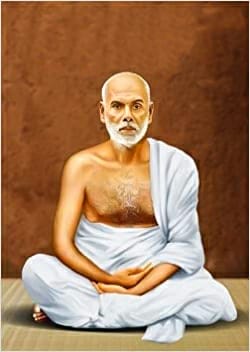Guru
On 26th August 1856 Srimati Kuttiamma, the wife of Shri Madanasan, a well known and respected scholar in Sanskrit, Tamil, Malayalam as also an adept Ayurveda vaidyan and resident of Vayalvaran veedu in Chempazhanty village in Trivandrum District gave birth to a boy who was named “Narayanan” but his parents, relatives and neighbours endearingly called him “Nanu”. Narayanan (Nanu) studied in Chempazhanti and later on shifted to Varanappally for higher studies under Kummampilly Raman Pillai Asan where he learnt Sanskrit Literature and Vedanta. As a little child he realized that social discrimination exists everywhere – at the class room, school, play ground, society and even in interactions between different sets of people; though little Nanu never understood its depth and ramifications. After the higher education, Nanu became Nanuasan to a lot of children. Social and domestic obligations forced him to lead a materialistic life but ultimately decided to leave his home for ever to lead a life of celibacy. To realize the ultimate truth Nanuasan chose a cave near Pillathadam under the foothills of Maruthwa Malai in Kanyakumari District and remained there in intense penance for a long time. He came out of the cave duly enlightened with “Brahmagnanam” after long and hard tapas.

After attaining the “Brahmagnanam” he chose Aruvippuram as his first karmabhumi and decided to initiate steps, one by one, to eradicate the discriminations being practiced between different segments of the society based on caste, creed, religion and job which was prevalent under the “chaturvarnam and promoted by higher caste. For a beginning, the young Brahmagnani consecrated a Shivlinga on a flat rock in Aruvippyuram on the Sivaratri day on 12th March 1888 and asked the assembled devotees to recite ‘aum namah sivaye’ and declared the place open to all kinds and types of devotees. The name and fame of the young Brahmagnani spread every nook and corner of Southern India which led the King of Travancore bestow him with the title Guru and he became Narayana Guru. Subsequent to the Aruvippuram Shivalinga consecration and many such pratishtas of different Hindu deities like, Lord Ganesh, Lord Shiv, Lordess Devi, the light of Lamp at Karamukku and ultimately ‘Aum inscribed on a Mirror at Kalavamkode, Chertala, Sree Narayana Guru advised his followers to stop constructing temples but concentrate on construction of schools to gain vidya. The three most preferred pratishtas / institution by Gurudev are – a) Shivalingam in Aruvippuram, b) Lordess Sharadadevi in Sivagiri Madom and the Adwaidasramam in Aluway. During Gurudev’s lifetime, Gurus 64 literary works can be broadly divided into three categories - Mystical Hymns, Philosophical and simple teachings for the common folks are so important in its literary value that one would fail to grade them the best amongst in all as each work was excellent pieces of literature. Sree Narayana Guru attained Mahasamadhi on 20th September 1928 but lives through endless devotees, believers and institutions the world over. Guru’s Darshanam and Vachans are as important today as a century plus back and will remain so in the coming years and centuries ahead.
| SOME IMPORTANT FACTS ABOUT MAHA GURU |
|---|
| The highest number of statues, libraries, monuments, roads, junctions, buses, autos, etc named after Sree Narayana Gurudevan. |
| Sri Lanka had issued a postage stamp in the name of Sree Narayana Guru, the only Keralite so far, to bestow great honour for his efforts in eradicating centuries old discriminations prevalent in Kerala society and achieved through peacefully but effectively. |
| The highest number of biographies, poems, biographical novels, essays, research papers, etc has been published in the name of Sree Narayana Guru. |
| The Government of Karnataka has included Guru’s works and his biography in their school syllabus. |
| The Government of Karnataka has also named a railway station in the name of Sree Narayana Guru. |
| The Government of Uttar Pradesh during Srimati Mayawati as Chief Minister installed a huge statue of Gurudevan at the Parivarthan Centre in Lucknow. |
| The Government of Kerala has officially printed and distributed at Government cost copies of Guru’s historical declaration “Jathiyilla Vilambaram’- (No Caste For Me). |
| The Government of Kerala for the first time in its history, a prayer song titled “DAIVADASAKAM” by Sree Narayana Guru has printed and distributed at Government cost on its Centenary. |
| For the first time, the Postal authorities released a postage stamp on a literary work from Kerala, based on the prayer song “DAIVADASAKAM” written by Sree Narayana Guru. |
| In 1985 Shri P Jayachandran bagged the Best Playback Singer Award for his song “Sivasankara sarva sharanya vibho…..” based on Guru’s Kruti “Shiva Prasada Panchakam”. |
| Dr K.J. Yesudas started his career in playback singing with his first song – Jathi Bhedam, Matha dwesham….” In the film “Kalpaadukal”. Recognition, laurels and awards showered and he never had to look back. Dr Yesudas has himself reminisced this on many occasions. |
| Shri Narendra Modi became Prime Minister of India on the 100 th day of his visit to Sivagiri Mutt. Prime Minister’s pooja room adorns the picture of Mahaguru, installed by the priests from Sivagiri Mutt. |
| The highest number of epics in Kerala is written in the name of Sree Narayana Guru. |
| The highest number of translations of biography is that of Narayana Guru by NBT of India, in 29 languages. |
| For the first time in Kerala, the Guru Jayanthi and Samadhi are declared as State Holidays is that of Sree Narayana Guru. |
